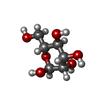+Search query
-Structure paper
| Title | Directed evolution of and structural insights into antibody-mediated disruption of a stable receptor-ligand complex. |
|---|---|
| Journal, issue, pages | Nat Commun, Vol. 12, Issue 1, Page 7069, Year 2021 |
| Publish date | Dec 3, 2021 |
 Authors Authors | Luke F Pennington / Pascal Gasser / Silke Kleinboelting / Chensong Zhang / Georgios Skiniotis / Alexander Eggel / Theodore S Jardetzky /   |
| PubMed Abstract | Antibody drugs exert therapeutic effects via a range of mechanisms, including competitive inhibition, allosteric modulation, and immune effector mechanisms. Facilitated dissociation is an additional ...Antibody drugs exert therapeutic effects via a range of mechanisms, including competitive inhibition, allosteric modulation, and immune effector mechanisms. Facilitated dissociation is an additional mechanism where antibody-mediated "disruption" of stable high-affinity macromolecular complexes can potentially enhance therapeutic efficacy. However, this mechanism is not well understood or utilized therapeutically. Here, we investigate and engineer the weak disruptive activity of an existing therapeutic antibody, omalizumab, which targets IgE antibodies to block the allergic response. We develop a yeast display approach to select for and engineer antibody disruptive efficiency and generate potent omalizumab variants that dissociate receptor-bound IgE. We determine a low resolution cryo-EM structure of a transient disruption intermediate containing the IgE-Fc, its partially dissociated receptor and an antibody inhibitor. Our results provide a conceptual framework for engineering disruptive inhibitors for other targets, insights into the failure in clinical trials of the previous high affinity omalizumab HAE variant and anti-IgE antibodies that safely and rapidly disarm allergic effector cells. |
 External links External links |  Nat Commun / Nat Commun /  PubMed:34862384 / PubMed:34862384 /  PubMed Central PubMed Central |
| Methods | EM (single particle) / X-ray diffraction |
| Resolution | 2.75 - 7.29 Å |
| Structure data | EMDB-25136, PDB-7sht:  PDB-7shu:  PDB-7shy:  PDB-7shz:  PDB-7si0: |
| Chemicals |  ChemComp-NAG:  ChemComp-EDO:  ChemComp-PO4:  ChemComp-HOH:  ChemComp-GOL:  ChemComp-MAN:  ChemComp-ACT:  ChemComp-NA: |
| Source |
|
 Keywords Keywords | IMMUNE SYSTEM / IgE / allergy / Xolair / Omalizumab / inhibitor / E27 |
 Movie
Movie Controller
Controller Structure viewers
Structure viewers About Yorodumi Papers
About Yorodumi Papers





 homo sapiens (human)
homo sapiens (human)